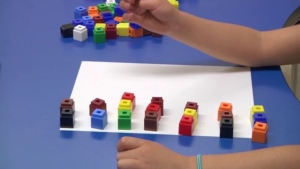What is direct modeling?
Direct modeling is when students show exactly what is happening in the problem, using manipulatives or pictures, to solve. Direct modeling is a powerful strategy that provides a foundation for the more advanced strategies that follow.
When should direct modeling be used?
The first step in developing a student’s understanding of a new math concept should be for them to directly model problems. If you don’t have the ability to model a problem, you cannot solve the problem. When a student struggles with a math problem, avoid referring to the operation (addition, subtraction, multiplication or division). Students who are struggling should be reminded to think about what is happening in the story and find a way to show it. As children grow in their sophistication, they will no longer need to and should not be expected to directly model every problem. Most students will directly model problems they find challenging, which should be encouraged.
What skills are improved through direct modeling?
Direct modeling supports student’s ability to contextualize and decontextualize. When students directly model a problem, they are contextualizing parts of the problem in order to show what is happening. For example, in the task “There are 8 bags of cookies with the same amount of cookies in each bag. If there are 48 cookies, how many cookies are in each bag?” students are expected to identify that 8 represents the number of cookie bags, 48 represents the number of cookies, and that it is unknown how many cookies are in each bag. While students directly model the problem, they should label what their manipulatives or picture represent. The ability to identify the meaning of the numbers in the problem will increase problem solving skills.
Strong direct modeling skills will also lead to student’s ability to decontextualize a problem. This means that they will be able to translate a task into numbers and symbols. Using the task in the previous paragraph, students who can decontextualize will be able to translate the situation in the equations: 8 x ____ = 48 or 48/8 = _____ and then solve the task. Why aren’t we decontextualizing the problem as ___ x 6 = 48? Many times we hear: What does it matter? You get the same answer anyways? Although we know that 8 x 6 = 48 and 6 x 8 = 48, the first equation matches what is happening in the problem, the second one does not. It is important that when we decontextualize we are still keeping in mind what we know about direct modeling.
